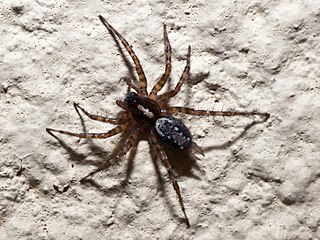
Solifugae is an order of animals in the class Arachnida known variously as camel spiders, wind scorpions, sun spiders, or solifuges. The order includes more than 1,000 described species in about 147 genera. Despite the common names, they are neither true scorpions, nor true spiders. Most species of Solifugae live in dry climates and feed opportunistically on ground-dwelling arthropods and other small animals. The largest species grow to a length of 12–15 cm (5–6 in), including legs. A number of urban legends exaggerate the size and speed of the Solifugae, and their potential danger to humans, which is negligible.

Carl Jakob Sundevall was a Swedish zoologist. Sundevall studied at Lund University, where he received a Ph.D. in 1823. After traveling to East Asia, he studied medicine, graduating as a Doctor of Medicine in 1830.

Galeodes is a genus of solifuges or sun spiders. The nearly 200 species in this genus are found in northern Africa, southeastern Europe and Asia. Like other solifuges, they are mainly nocturnal and found in arid habitats. They often have long hairy appendages and are not as stout bodied or dark and contrastingly coloured as some other solifuges. Some Galeodes species are able to produce sounds by stridulation. These are usually raspy or hiss-like and may be imitations of the sounds of vipers, to serve a defensive function. As in other solifuges, mating involves the male depositing a spermatogonia that is manipulated into the female genital opening using their chelicera. The male strokes the female using the palps allowing her to be approached. Females will often feed on males before or after mating. The female then deposits the eggs in a burrow in soil and in some species guards them.

Anyphaena is a genus of anyphaenid sac spiders first described by Carl Jakob Sundevall in 1833.

Textrix is a genus of funnel weavers first described by Carl Jakob Sundevall in 1833. They have a mainly European distribution, with one species in Ethiopia. The type species of the genus is Textrix denticulata.

Asagena is a genus of comb-footed spiders that was first described by Carl Jakob Sundevall in 1833.
Biton is a genus of daesiid camel spiders, first described by Ferdinand Karsch in 1880.
Gluviopsis is a genus of daesiid camel spiders, first described by Karl Kraepelin in 1899.
Gluviopsona is a genus of daesiid camel spiders, first described by Carl Friedrich Roewer in 1933.
Gylippidae is a family of solifuges, first described by Carl Friedrich Roewer in 1933.
Karschia is a genus of karschiid camel spiders, first described by Alfred Walter in 1889.
Paragaleodiscus is a monotypic genus of Galeodid camel spiders, first described by Aleksei Birula in 1941. Its single species, Paragaleodiscus aflagellatus is distributed in Yemen.
Roeweriscus is a monotypic genus of Galeodid camel spiders, first described by Aleksei Birula in 1937. Its single species, Roeweriscus paradoxus is distributed in Iran.
Galeodopsis is a genus of Galeodid camel spiders, first described by Aleksei Birula in 1903.

Paragaleodes is a genus of galeodid camel spiders, first described by Karl Kraepelin in 1899.
Rhagodixa is a genus of rhagodid camel spiders, first described by Carl Friedrich Roewer in 1933.
Rhagodopa is a genus of rhagodid camel spiders, first described by Carl Friedrich Roewer in 1933.
Gylippus is a genus of gylippid camel spiders, first described by Eugène Simon in 1879.
Oparbella is a genus of solpugid camel spiders, first described by Carl Friedrich Roewer in 1934.
Solpugiba is a genus of solpugid camel spiders, first described by Carl Friedrich Roewer in 1934.







